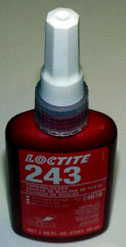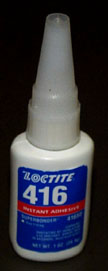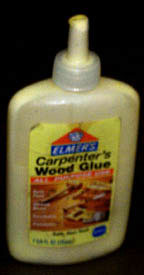2.007 Kit Part: Adhesives
www.loctite.com
 |

|
 |

|
Hot Melt Glue |
1 Loctite 243 |
2 Loctite 416 |
3 Wood Glue |
4 |
5 Hot melt glue |
| Set time ~ 2 hours |
Set time - 50 - 60 seconds |
Set time ~ 1 hour (can vary widely, see back of bottle) |
|
Set time - 30 seconds |
| Gap filling capability - 0.15mm |
Gap filling capability - 0.008 in. |
Gap filling capability ~ 0.01 in. |
|
Gap filling capability ~ 0.1 in. |
| Breakloose torque on M10 steel nut & bolt - 210 in-lb |
Approximate tensile strength 2500 psi |
|
|
Melting temperature ~ 300° F |
| Dimethacrylate ester |
Ethyl cyanoacrylate |
|
|
|
|
Cured material |
Typical Shear strength Range |
|
|
|
Grit blasted steel |
2600 - 3800 psi |
|
|
|
Etched aluminum |
1600 -2800 psi |
|
|
|
ABS |
900 - 2900 psi |
|
|
|
PVC |
900 - 2900 psi |
|
|
|
Polycarbonate |
700 -2900 psi |
|
|
|
Tensile strength |
|
|
|
|
|
Grit blasted steel |
1700 - 3600 psi |
|
|
|
Buna-N rubber |
700 - 2200 psi |
|
|
Possible uses:
- Gluing wood, porous material together 2, 3, epoxy
- Locking threads 1 (removable), 2 (permanent)
- Gluing metal (rough up the surface) 2 ,epoxy
- Gluing rubber bands, belts 2, hot glue ok in some cases
- Gluing plastics 2
- Laminating aluminum to wood 2, epoxy. roughen the metal with sandpaper, 4(spray glue)
Tips:
1 Loctite 243:
Threadlocker should be used whenever the bolted joint in question is subject to
reversing loads, vibrating loads or has the potential to loosen due to relative motion of
the parts it is clamping.
You should only use threadlocker when you are near completion of your machine or a
complete subsystem as it makes it much more difficult to remove the fasteners with the
threadlocker cured.
Threadlocker is not required on static bolted joints.
To correctly apply threadlocker, make sure both the nut and bolt are free of grease,
oil and any other contaminants, then put a small dab on the nut and tighten the joint. Do
not stress the joint for at least one hour.
2 Loctite 416:
This is a thick cyanoacrylate glue, or "superglue." It will stick to your
skin very permanently. This glue cures very hard, but somewhat brittle. It is probably the
best thing in the kit for gluing metal and plastic, but is not nearly as good as a solid
mechanical connection or one made with glue formulated for a specific plastic.
This looks like the best glue to bolster press fits between the black plastic flanges
and wheels, for example.
This glue cures according to its exposed surface area-- be careful when using on cloth
or other very porous material, as it may cure fast enough to get hot, or produce very
eye-irritating fumes.
3 Wood Glue:
Wood glue is really only effective for bonding wood products to other wood products.
Therefore, wood glue should really only be used to bond basswood to basswood.
Laminating two or more wood boards together is a very common practice in woodworking.
You can bond multiple strips together using clamps to keep pressure on the joints for at
least an hour. Once the glue has dried, you can cut or drill through the parts almost as
if they were a single large block of wood. (Just don't cut or drill directly on one of the
joints.)
4 Assorted Glues in Cans
Includes 3M 77 or similar spray adhesive, Loctite cleaner, Loctite epoxy(?), etc. The
spray glue is the best thing for sticking paper drawings onto sheetmetal as a guide for
shearing, notching, punching and bending.
5 Hot Melt Glue:
Hot melt glue is a low strength adhesive that bonds well to porous materials such as
wood, fabric and paper products. It is not a very effective adhesive for bonding smooth
plastics or metals.
A rough surface will provide a better bond than a smooth one.
Hot melt glue can be used effectively as strain relief or tack downs for electrical
and/or pneumatic hoses.



